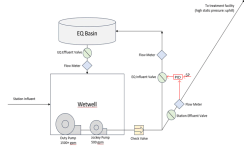ryangriggs
Lifetime Supporting Member
Hello, I am attempting to tune a PID loop on a process. The process involves a valve with electronic actuator that has quite a high deadband: approx 2-3% of total valve range.
The valve is set up to divert flow from a pipe if the pipe's flow rate exceeds a setpoint.
The valve output is very sensitive, causing large changes in main pipe flow when the position is changed by a very small amount (1% or less).
Due to these factors, I'm finding that the process oscillates when attempting to modulate low flow rates, as only a couple percentage points of change in position will basically cut off the flow or wildly overshoot. It seems to work reasonably well at higher flow rates, however.
Does anyone have any tips for tuning the PID loop in such a case, and/or designing around a high deadband?
Thanks!
The valve is set up to divert flow from a pipe if the pipe's flow rate exceeds a setpoint.
The valve output is very sensitive, causing large changes in main pipe flow when the position is changed by a very small amount (1% or less).
Due to these factors, I'm finding that the process oscillates when attempting to modulate low flow rates, as only a couple percentage points of change in position will basically cut off the flow or wildly overshoot. It seems to work reasonably well at higher flow rates, however.
Does anyone have any tips for tuning the PID loop in such a case, and/or designing around a high deadband?
Thanks!









